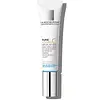What's inside
What's inside
 Key Ingredients
Key Ingredients

 Benefits
Benefits

 Concerns
Concerns

 Ingredients Side-by-side
Ingredients Side-by-side

Water
Skin ConditioningGlycerin
HumectantDimethicone
EmollientButyrospermum Parkii Butter
Skin ConditioningLimnanthes Alba Seed Oil
Skin ConditioningAscorbic Acid
AntioxidantMannose
HumectantButylene Glycol
HumectantParaffinum Liquidum
EmollientAmmonium Polyacryloyldimethyl Taurate
Emulsion StabilisingCetyl Alcohol
EmollientPEG-100 Stearate
Glyceryl Stearate
EmollientPolymethylsilsesquioxane
Potassium Hydroxide
BufferingParaffin
PerfumingSodium Styrene/Ma Copolymer
Emulsion StabilisingCera Microcristallina
Emulsion StabilisingMadecassoside
AntioxidantDimethicone/Vinyl Dimethicone Crosspolymer
Skin ConditioningDimethiconol
EmollientDisodium EDTA
Hydrolyzed Hyaluronic Acid
HumectantCaprylyl Glycol
EmollientAcetyl Dipeptide-1 Cetyl Ester
Skin ConditioningXanthan Gum
EmulsifyingPentaerythrityl Tetra-Di-T-Butyl Hydroxyhydrocinnamate
AntioxidantPhenoxyethanol
PreservativeWater, Glycerin, Dimethicone, Butyrospermum Parkii Butter, Limnanthes Alba Seed Oil, Ascorbic Acid, Mannose, Butylene Glycol, Paraffinum Liquidum, Ammonium Polyacryloyldimethyl Taurate, Cetyl Alcohol, PEG-100 Stearate, Glyceryl Stearate, Polymethylsilsesquioxane, Potassium Hydroxide, Paraffin, Sodium Styrene/Ma Copolymer, Cera Microcristallina, Madecassoside, Dimethicone/Vinyl Dimethicone Crosspolymer, Dimethiconol, Disodium EDTA, Hydrolyzed Hyaluronic Acid, Caprylyl Glycol, Acetyl Dipeptide-1 Cetyl Ester, Xanthan Gum, Pentaerythrityl Tetra-Di-T-Butyl Hydroxyhydrocinnamate, Phenoxyethanol
Water
Skin ConditioningJojoba Esters
EmollientHelianthus Annuus Seed Oil
EmollientGlycerin
HumectantCaprylic/Capric Triglyceride
MaskingCetearyl Alcohol
EmollientPEG-100 Stearate
Glyceryl Stearate
EmollientC10-18 Triglycerides
EmollientSilica
AbrasivePalmitoyl Tripeptide-1
Skin ConditioningPalmitoyl Tetrapeptide-7
Skin ConditioningGold
Cosmetic ColorantCamellia Sinensis Leaf Powder
ExfoliatingTocopherol
AntioxidantButylene Glycol
Humectant1,2-Hexanediol
Skin ConditioningHydroxyacetophenone
AntioxidantCarbomer
Emulsion StabilisingPolysorbate 20
EmulsifyingPotassium Cetyl Phosphate
EmulsifyingAcrylates/C10-30 Alkyl Acrylate Crosspolymer
Emulsion StabilisingMica
Cosmetic ColorantTromethamine
BufferingDisodium EDTA
CI 77891
Cosmetic ColorantWater, Jojoba Esters, Helianthus Annuus Seed Oil, Glycerin, Caprylic/Capric Triglyceride, Cetearyl Alcohol, PEG-100 Stearate, Glyceryl Stearate, C10-18 Triglycerides, Silica, Palmitoyl Tripeptide-1, Palmitoyl Tetrapeptide-7, Gold, Camellia Sinensis Leaf Powder, Tocopherol, Butylene Glycol, 1,2-Hexanediol, Hydroxyacetophenone, Carbomer, Polysorbate 20, Potassium Cetyl Phosphate, Acrylates/C10-30 Alkyl Acrylate Crosspolymer, Mica, Tromethamine, Disodium EDTA, CI 77891
Ingredients Explained
These ingredients are found in both products.
Ingredients higher up in an ingredient list are typically present in a larger amount.
Butylene Glycol (or BG) is used within cosmetic products for a few different reasons:
Overall, Butylene Glycol is a safe and well-rounded ingredient that works well with other ingredients.
Though this ingredient works well with most skin types, some people with sensitive skin may experience a reaction such as allergic rashes, closed comedones, or itchiness.
Learn more about Butylene GlycolDisodium EDTA plays a role in making products more stable by aiding other preservatives.
It is a chelating agent, meaning it neutralizes metal ions that may be found in a product.
Disodium EDTA is a salt of edetic acid and is found to be safe in cosmetic ingredients.
Learn more about Disodium EDTAGlycerin is already naturally found in your skin. It helps moisturize and protect your skin.
A study from 2016 found glycerin to be more effective as a humectant than AHAs and hyaluronic acid.
As a humectant, it helps the skin stay hydrated by pulling moisture to your skin. The low molecular weight of glycerin allows it to pull moisture into the deeper layers of your skin.
Hydrated skin improves your skin barrier; Your skin barrier helps protect against irritants and bacteria.
Glycerin has also been found to have antimicrobial and antiviral properties. Due to these properties, glycerin is often used in wound and burn treatments.
In cosmetics, glycerin is usually derived from plants such as soybean or palm. However, it can also be sourced from animals, such as tallow or animal fat.
This ingredient is organic, colorless, odorless, and non-toxic.
Glycerin is the name for this ingredient in American English. British English uses Glycerol/Glycerine.
Learn more about GlycerinGlyceryl Stearate is a mix of glycerin and stearic acid.
It is used to stabilize the mixing of water and oil ingredients. By preventing these ingredients from separating, it can help elongate shelf life. It can also help thicken the product's texture.
As an emollient, it helps soften skin and supports barrier-replenishing ingredients.
In cosmetics, Glyceryl Stearate is often made from vegetable oils or synthetically produced.
This ingredient may not be fungal-acne safe
Fun fact: The human body also creates Glyceryl Stearate naturally.
Learn more about Glyceryl StearatePeg-100 Stearate is an emollient and emulsifier. As an emollient, it helps keep skin soft by trapping moisture in. On the other hand, emulsifiers help prevent oil and water from separating in a product.
PEGS are a hydrophilic polyether compound . There are 100 ethylene oxide monomers in Peg-100 Stearate. Peg-100 Stearate is polyethylene glycol ester of stearic acid.
Water. It's the most common cosmetic ingredient of all. You'll usually see it at the top of ingredient lists, meaning that it makes up the largest part of the product.
So why is it so popular? Water most often acts as a solvent - this means that it helps dissolve other ingredients into the formulation.
You'll also recognize water as that liquid we all need to stay alive. If you see this, drink a glass of water. Stay hydrated!
Learn more about Water